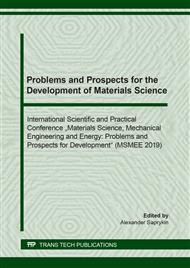[1]
Y. Lu, S. Wu, Y. Gan, J. Li, C. Zhao, D. Zhuo, J. Lin, Investigation on the microstructure, mechanical property and corrosion behavior of the selective laser melted CoCrW alloy for dental application, Mater. Sci. Eng.: C 49 (2015) 517–525.
DOI: 10.1016/j.msec.2015.01.023
Google Scholar
[2]
B. Song, S. Dong, Q. Liu, et al., Vacuum heat treatment of iron parts produced by selective laser melting: microstructure, residual stress and tensile behavior, Mater. Des. 54 (2014) 727–733.
DOI: 10.1016/j.matdes.2019.108335
Google Scholar
[3]
A. A. Saprykin, N. A. Saprykina, Improvement of surface layer formation technology for articles produced by layer-by-layer laser sintering, Applied Mechanics and Materials. 379 (2013) 56-59.
DOI: 10.4028/www.scientific.net/amm.379.56
Google Scholar
[4]
J.-H. Cho, S.-J. Na, Implementation of real-time multiple reflection and Fresnel absorption of laser beam in keyhole, J. Phys. D: Appl. Phys. 39 (24) (2006)5372.
DOI: 10.1088/0022-3727/39/24/039
Google Scholar
[5]
A. Takaichi, T. Nakamoto, N. Joko, et al., Microstructures and mechanical properties of Co–29Cr–6Mo alloy fabricated by selective laser melting process for dental applications, J. Mech. Behav. Biomed. Mater. 21 (2013) 67–76.
DOI: 10.1016/j.jmbbm.2013.01.021
Google Scholar
[6]
B. Song, S. Dong, B. Zhang, et al., Effects of processing parameters on microstructure and mechanical property of selective laser melted Ti6Al4V[J], Mater. Des. 35 (2012) 120–125.
DOI: 10.1016/j.matdes.2011.09.051
Google Scholar
[7]
D. Dai, D. Gu, Thermal behavior and densification mechanism during selective laser melting of copper matrix composites: simulation and experiments [J], Mater. Des. 55 (2014) 482–491.
DOI: 10.1016/j.matdes.2013.10.006
Google Scholar
[8]
A. Simchi, Direct laser sintering of metal powders: mechanism, kinetics and microstructural features [J], Mater. Sci. Eng. A 428 (1) (2006) 148–158.
DOI: 10.1016/j.msea.2006.04.117
Google Scholar
[9]
S. Leuders, M. Thöne, A. Riemer, et al., On the mechanical behaviour of titanium alloy TiAl6V4 manufactured by selective laser melting: fatigue resistance and crack growth performance, Int. J. Fatigue. 48 (2013) 300–307.
DOI: 10.1016/j.ijfatigue.2012.11.011
Google Scholar
[10]
Y. Kajima, A. Takaichi, N. Kittikundecha, T. Nakamoto, T. Kimura, N. Nomura, A. Kawasaki, T. Hanawa, H. Takahashi, N. Wakabayashi, Effect of heat-treatment temperature on microstructures and mechanical properties of Co–Cr–Mo alloys fabricated by selective laser melting, Mater. Sci. Eng. 726 (2018) 21–31.
DOI: 10.1016/j.msea.2018.04.048
Google Scholar
[11]
A. S. Yanyushkin, О. I. Medvedeva, N. A. Saprykina, Mechanism of Protective Membrane Formation on the Surface of Metal-Bonded Diamond Disks, Applied Mechanics and Materials. 682 (2014) 327-331.
DOI: 10.4028/www.scientific.net/amm.682.327
Google Scholar
[12]
A. A. Saprykin, N. A. Saprykina, D. V. Dudikhin, S. M. Emelyanenko, Influence of layer-by-layer laser sintering modes on the thickness of sintered layer of cobalt-chromium-molybdenum powder, Advanced Materials Research. 1040 (2014) 805-808.
DOI: 10.4028/www.scientific.net/amr.1040.805
Google Scholar
[13]
A. A. Saprykin, E. A. Ibragimov , E. V. Babakova, Modeling the Temperature Fields of Copper Powder Melting in the Process of Selective Laser Melting, IOP Conference Series: Materials Science and Engineering. 142(1) (2016) 012061.
DOI: 10.1088/1757-899x/142/1/012061
Google Scholar
[14]
Y. Liu, Y. Yang, S. Mai, et al., Investigation into spatter behavior during selective laser melting of AISI 316 L stainless steel powder, Mater. Des. 87 (2015) 797–806.
DOI: 10.1016/j.matdes.2015.08.086
Google Scholar
[15]
A. A. Saprykin, N. A. Saprykina, Engineering support for improving quality of layer-by-layer laser sintering, 7th International Forum on Strategic Technology IFOST. (2012) 6357719.
DOI: 10.1109/ifost.2012.6357719
Google Scholar
[16]
C. Song, M. Zhang, Y. Yang, D. Wang, Y. Jia-kuo, Morphology and properties of CoCrMo parts fabricated by selective laser melting, Mater. Sci. Eng.: A 713 (2018) 206–213.
DOI: 10.1016/j.msea.2017.12.035
Google Scholar
[17]
A. Ladewig, G. Schlick, M. Fisser, V. Schulze, U. Glatzel, Influence of the shielding gas flow on the removal of process by-products in the selective laser melting process, Addit. Manuf. 10 (2016) 1–9.
DOI: 10.1016/j.addma.2016.01.004
Google Scholar
[18]
A. A. Saprykin, E. A. Ibragimov , E. V. Babakova, V. I. Yakovlev, Influence of mechanical activation of copper powder on physicomechanical changes in selective laser sintering products, AIP Conference Proceedings. 1683 (2015) 020199.
DOI: 10.1063/1.4932889
Google Scholar
[19]
S.A. Khairallah, A.T. Anderson, A. Rubenchik, et al., Laser powder-bed fusion additive manufacturing: physics of complex melt flow and formation mechanisms of pores, spatter, and denudation zones, Acta Mater. 108 (2016) 36–45.
DOI: 10.1016/j.actamat.2016.02.014
Google Scholar


